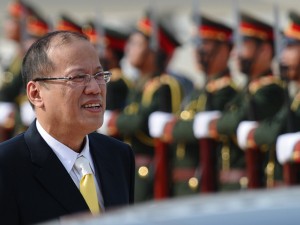PHNOM PENH, Cambodia—Relations between the Philippines and Cambodia, soured by differences over how to approach the West Philippine Sea (South China Sea) disputes, are expected to improve as President Aquino arrives here on Saturday for the biannual summit of Southeast Asian leaders.
Mr. Aquino will attend the 21st Asean Summit and related summits, where he will call on members of the bloc to speak with one voice in dealing with China on territorial disputes in the West Philippine Sea.
He hopes to receive support from the United States and other Western countries, whose leaders are also attending the summit, in pressing for a united stand against China’s increasingly assertive behavior in the West Philippine Sea, believed to hold vast deposits of oil and gas and which is home to sea-lanes through which half of the global trade passes.
US President Barack Obama and leaders of the European Union, Australia, New Zealand, Japan, South Korea, India and China are attending the summit.
Speaking to reporters in the mountain resort city of Baguio on Thursday, Mr. Aquino said he hoped other countries outside of Asean realized it was necessary to maintain stability in the West Philippine Sea for the region’s growth to continue.
Mending relations
Philippine Ambassador to Cambodia Noe Wong said the two neighbors had made progress in strengthening relations this year in spite of a diplomatic row over how the 10-member Association of Southeast Asian Nations (Asean) should deal with China, Cambodia’s ally and benefactor.
China insists it has sovereign rights to nearly all of the West Philippine Sea despite the competing claims of four Asean countries—Brunei, Malaysia, the Philippines and Vietnam.
Asean also includes Cambodia, Indonesia, Laos, Burma (Myanmar), Singapore and Thailand.
Relations between Cambodia and the Philippines soured in July after Cambodia blocked efforts by the Philippines and Vietnam to mention their run-ins with China in the West Philippine Sea in the customary joint communiqué that was to be issued at the end of an Asean ministerial meeting here.
As a result, Asean failed to issue a joint communiqué for the first time in its 45-year history.
“I think we have made progress for 2012 even (if) the July thing that you were asking me a while ago (happened),” Wong said in an interview with Radio-Television Malacañang here.
“There are contentious issues, of course, but overall I could say that we are making progress toward that… The contentious issues are only part of the so many issues that we are going to consider,” he said.
The spat between the Philippines and Cambodia came to a head in August when Phnom Penh’s ambassador to Manila, Hos Sereythonh, wrote a letter to a newspaper accusing the Philippines and Vietnam of “dirty politics.”
A Philippine protest led to Sereythonh’s recall.
No rifts?
Analysts said the episode showed deep rifts within Asean that could derail work toward a code of conduct in the West Philippine Sea, which had been proposed to prevent territorial disputes in the area from erupting into armed confrontations.
But the Department of Foreign Affairs (DFA) sees no such rifts in Asean.
When asked at a recent briefing if the summit here provided a chance for mending relations, DFA spokesperson Raul Hernandez said there was nothing to fix.
“I think that issue has already been addressed with the submission and also with the approval of the six-point [consensus] that was initiated by Indonesia,” Hernandez said.
Shuttle diplomacy by Indonesian Foreign Minister Marty Natalegawa after the failed Asean meeting here in July led to the adoption of the “six points of consensus,” which affirmed, among other principles, Asean’s commitment to the 2002 Declaration on the Conduct of Parties in the South China Sea. The bloc’s members also agreed to work toward the early adoption of a legally binding code of conduct in the sea.
Different dynamics
Hernandez said the 21st Asean summit and related meetings would have “totally different dynamics.”
“We are hoping and expecting that there will be smooth and very productive results of these meetings as far as our advocacies are concerned,” Hernandez said.
He noted that Asean had already taken the “first crack” at the drafting of the code of conduct. “In fact, we have already the elements that Asean members have approved and are ready to present to China,” Hernandez said.
“What is important here is to underscore the Asean centrality and, for Asean, it has always been our position that any initiatives should first be accepted and approved by Asean and only then would it be presented to other dialogue partners,” he said.
Wong said Cambodia’s chairmanship of the 2012 meetings helped Asean build the political security, economic and sociocultural pillars of the community, and that its relations with the Philippines were better than ever.
“Now, Cambodia and the Philippines have excellent bilateral relations. Both countries until now are continuing their efforts to strengthen cooperation in areas [that] are of mutual interest and benefit,” he said.
Wong noted that contacts between the two countries date back to the 6th century through the trade routes established by Malays in Southeast Asia. But formal diplomatic relations between Manila and Phnom Penh began only in 1957.
Filipinos in Cambodia
“Officially,” Wong said, there are 3,497 Filipinos in Cambodia, most of them employed in the garments and textile industry, hotels and restaurants, academic institutions and nongovernmental organizations.
“I said officially because this is the number of Filipinos who registered in the consular office or in the embassy. But, in my estimate, I could safely say that maybe between 5,000 to 6,000 Filipinos are here,” he added.
Dialogues and consultations between Manila and Phnom Penh will continue through the Joint Conference on Bilateral Cooperation, Wong said. With a report from AFP
